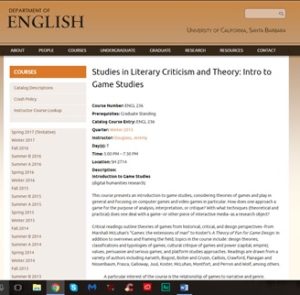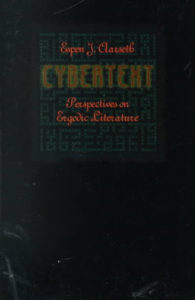Jenkins, Henry. “Game Design as Narrative Architecture”. In The Game Design Reader: A Rules of Play Anthology, Ed. Katie Salen and Eric Zimmerman. MIT P, Cambridge, MA, 2006.
In the introduction to “Game Design as Narrative Architecture,” Henry Jenkins states that when first presented at a conference, the essay, “provoked strong reactions from the so-called Ludologists and resulted in my being falsely (in my opinion) identified as a Narratologist.” He goes on to explain that his ideas are more centered on game spaces, “ripe with narrative possibility,” while story itself can be deconstructed as “less a temporal structure than a body of information.”
While he devotes considerable time to finding common ground between Narratologists and Ludologists, his primary point is that games are spaces. This is true whether it is the board of Monopoly, which he alludes to, or the vast outer space reaches of the 2016 release No Man’s Sky, with it’s 18 quintillion planets to be explored. While he says that he was “falsely” lumped in with Narratologists, the main gist of his article does deal with narrative – but not necessarily linear narrative. His description of games, or perhaps ideal games, allows for a great deal of player agency to discover a narrative and piece it together on their own, rather than being forced on rails to live the narrative themselves, along a linear path that the author/designer wants them to follow. He explains the game world as “a kind of information space, a memory palace,” if the designer intends a more linear path, or a space in which the player can “explore the game space and unlock its secrets”. Either way, it is about discovery of an existing story, rather than the player character’s own heroic journey.

He cites the work of Don Carson, who has written on the lessons game designers can take from the work of theme park designers, observing that “the art of game design comes in finding artful ways of embedding narrative information into the environment without destroying its immersiveness and without giving the player a sensation of being drug around by the neck.” This single sentence encapsulates what is perhaps the most important concept in this article as a whole – the importance of immersion in the experience of a game, the need for player agency in

exploring an environment and uncovering the story for themselves, and the reason why standard models of narrative borrowed from literary and film studies are of limited use when applied to (some) game stories. And while some resist (and others embrace) the idea of games as “art”, in a traditional sense, Jenkins is speaking more of artful design – the creation of something functional in a way that is seamlessly integrated into its environment, as opposed to something that stands out as unique within its own context.

While some games do have linear stories, and some have no stories at all, if a designer wants to tell a story that is unique to the medium of game design, it is necessary to do so using a framework that goes beyond that of traditional print and motion media.
So while Jenkins seemingly bristled at the idea of being called a Narratologist, his perspective is an interesting middle ground, seemingly doing exactly what Aarseth calls for in his essay “Computer Game Studies, Year One”. While Jenkins is interested in the idea of narrative (with a small “n”), which would cause some to place him in with the Narratologist camp, his concept is decidedly non-linear and as such goes beyond what traditional scholars of narrative could apply existing models to. Just as Aarseth has challenged game scholars to carve out their own niche, independent of existing fields, Jenkins has done just that.
The article situates the field of game design studies as being separate from, but arguably both complimentary and adjacent to that of English studies. While his concept of narrative spaces is unlike the linear narrative structure familiar to scholars of literature, and even that of nonlinear hypertext narrative, English scholars who are open minded enough to look beyond existing theoretical models will find fertile ground in analysis of these narrative spaces. Within the bounds Jenkins sets in this article, he defines a theoretical space between Narratologists and Ludologists, outside of the domains of literary and cinema studies scholars, but also scholars of computer science, animation, and art. His notion of narrative space works equally well to imagine a flag being planted in a new domain belonging to computer game theorists.
Additional Reading
The ubiquitous Extra Credits video I’ve paired with this deals with “Negative Possibility Space” – dealing with player agency and how that relates to the physical space being explored by characters.
Jenkins mentions The Image of the City, a book dealing with city planning and urban design, as being useful for designers in understanding how people live, work, and play in designed spaces.



